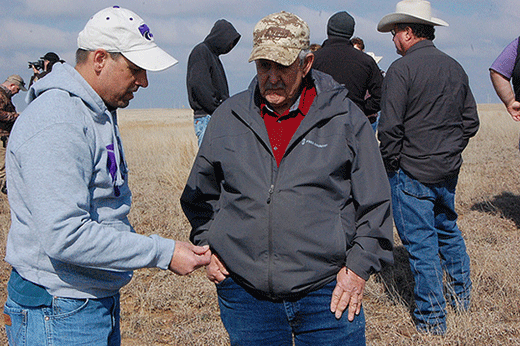
Range scientist Keith Harmoney from the Western Kansas Agricultural Center in Hays talks with rancher Dave Bouziden about the condition of grass on his farm. | Download this photo.
Clark County farmers continue recovery from historic fire
K-State hosts meeting to share updates, information on bringing pastures back
March 28, 2019
ASHLAND, Kan. – Out here in rural America, people take care of each other.
In fact, more than two years after the worst wildfire ever recorded in Kansas swept through several southwest Kansas counties, they’re still doing it.
“It was a natural disaster,” said Ashland resident Adam Elliott, who is also a volunteer firefighter and the district conservationist with the Natural Resources Conservation Service.
In Kansas alone, the Starbuck Fire consumed approximately 660,000 acres, much of that in Clark, Comanche and Meade counties. Estimates tagged the property damage at more than $44 million, as winds in excess of 60 mph quickly fanned the flames. Thousands of head of cattle died in the fire, which reached temperatures up to 1,600 degrees Fahrenheit.
“Nature is healing itself; it was prepared for fires like this. But our ranching community is still recovering,” Elliott said. “Two years later, we’re still just trying to get all the fence re-built, get water supplies, get ready for the grazing season coming up.”
Nearly three dozen area residents got together in late March for an update on recovery efforts in Clark County, where reports indicate that about 75 percent of the county – or 400,000 acres -- was scarred.
The meeting was set up by K-State Research and Extension to provide support and education to farmers who continue to replace fence, stock herds and replenish grass in their pastures.
“It’s something I hope nobody ever has to experience again,” said Dave Bouziden, whose family lost their home, pets, farm buildings, equipment and most of their pasture and cattle.
“Thank goodness it’s two years behind us. We’ve come a long ways since the fire. With the moisture we’ve had this year and the grass population, we are almost back to normal, along with the cattle.”
Bouziden estimates that pastures on his property – crucial for grazing cattle – are at about 75 percent of what they were before the fire.
“Right now because of our cold temperatures, our grass hasn’t begun to regenerate for the spring yet,” said Brice Gibson, K-State Research and Extension agriculture and natural resources agent in Clark County. “Our grass looks really good driving 70 (mph) down the highway, but once you get into the field, it’s a little less densely populated from where it was two years ago.”
Keith Harmoney, a range scientist with K-State’s Western Kansas Agricultural Research Center in Hays, was on hand to answer questions and help farmers understand what to look for in healthy pastures.
“Our rangelands evolved with fire, so they’re adapted to being able to recover,” Harmoney said. “But usually we want to have those burns occur under more managed conditions than what happened during those fires in March, 2017.”
Harmoney told residents that pastures recover more quickly from fire when there is soil or plant cover available. Bare pastures become more susceptible to wind and water erosion.
“That’s what we do with prescribed burning,” he said. “We usually do it at a time of year and under soil conditions where we have moist soil so we get rapid growth.”
Elliott said that the local NRCS office received approximately $18 million to help build 1,600 miles of fence in Clark County alone; most of that work has been completed. Some reports indicate that 4,100 miles of fence were damaged or destroyed in the affected counties, including northern Oklahoma.
“The generosity of people sending hay and fencing materials is at times overwhelming,” said Dave Arnold, whose ranch is approximately 10 miles south of Ashland just inside the Oklahoma border. “I still well up thinking about all of the things we gained out of the fire; not just what we lost, but the friendships and associations that come from it. I still get emotional about it.”
Nathan Shoup, who raises cattle in Sitka, Kansas, about 10 miles east of Ashland, remembers strangers coming to his aid within hours after the Starbuck fire burned his pastures.
“I probably can’t say it without a tear to my eyes, but I can’t say enough about the…” his voice trails off, then: “…the hay that came in was the best thing that happened for my situation.”
Within days Shoup, who has just one half-time employee normally, had 15 volunteers helping him clean up the farm and build fence.
“You don’t realize how giving people are, that is for certain,” Elliott said. “If there’s one thing you can’t prepare for, it’s all the people wanting to come help from all over. Kids on their spring break at that point came out here to help build fence, and clean up fence. Youth groups, church groups… Our population probably doubled during that time just because of all the people that came to town.
“And it’s not like they just threw money at us, either. It was the true sentiment of helping. They got their hands bloody rolling up all that old barb wired fence and cleaning up those posts… helping people with their burnt houses.
“That’s not just ‘oh yeah, I’m concerned about it.’ That’s genuine. People saying let’s come out and help these guys because they’ve had a hard knock here. It was good. It really put some faith back into human kind.”

